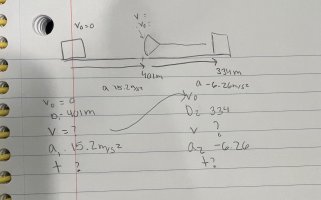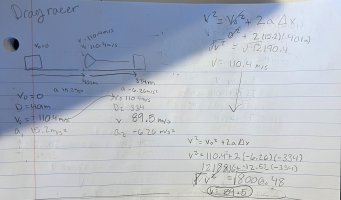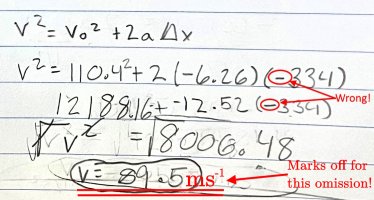Hi @Amelinator,
Whenever I am teaching Physics (or indeed Maths, for similar types of problems) I exhort my pupils to always follow the same procedure.
In dealing with problems involving the Equations of Motion it's important, obviously, that the student knows these; we teach them (here, in Bonnie Scotland) as:-
[imath]v=u+at\\s=ut+\frac{1}{2}at^2\\and\\v^2-u^2=2as[/imath]
which @khansaheb has very kindly rearranged for you to: \(\displaystyle v^2=u^2+2as\)
I see you are following something along similar lines to what I teach but note that you are using v0 for initial (or starting?) velocity instead of \(\displaystyle u\) and "D" for displacement (or distance?) instead of \(\displaystyle s\).
(I would discourage the use of the names I've put in brackets.  )
)
You're free to use whatever you like, of course, but I would advise sticking to the variable names used in the original formulae; just to prevent any potential confusion.
I would also advise you to follow this procedure for every calculation you embark upon involving the Equations of Motion (EoM):-
0. Draw a sketch (if appropriate/required).
1. List all the variables. (Include all five for EoM calcs. ie: "\(\displaystyle u~v~a~s~t\)")
2. Assign values to those you know.
3. Identify (Tick?) the unknown value you need to find.
4. Choose (and write down) the formula that includes your known values and your desired unknown.
5. Substitute your known values into the chosen equation.
6. Rearrange (if reqd.) and solve the equation to get your desired value.
So, for your initial part of the problem (the bit you say you're struggling with), I would write down:-
[imath]u=0\\ v= ~?~\checkmark\\a=15.2~ms^{-2}\\s=401~m\\t=~?[/imath]
Then, choosing, \(\displaystyle v^2-u^2=2as\), I would write:-
\(\displaystyle v^2-u^2=2as\\ \implies v^2-0^2=2\times 15.2\times 401\\ \implies v^2=0+12,190.4\\ \implies v=\sqrt{12,190.4}\\ \implies \underline{\underline{v=~??~ms^{-1}}}\)
(Always double underline your final answers.  )
)
And be sure to include the Units (like ms-1) in any "final" answers!
If you follow that procedure throughout you should have no further difficulties in reaching the final solution required by the problem as given.
(I would also call a negative value for \(\displaystyle a\) "decelleration" but that's perhaps just semantics.  )
)
Please now come back and show us your working as employed to reach the final solution requested by the problem as stated.
Thank you.
Hope that helps. 




